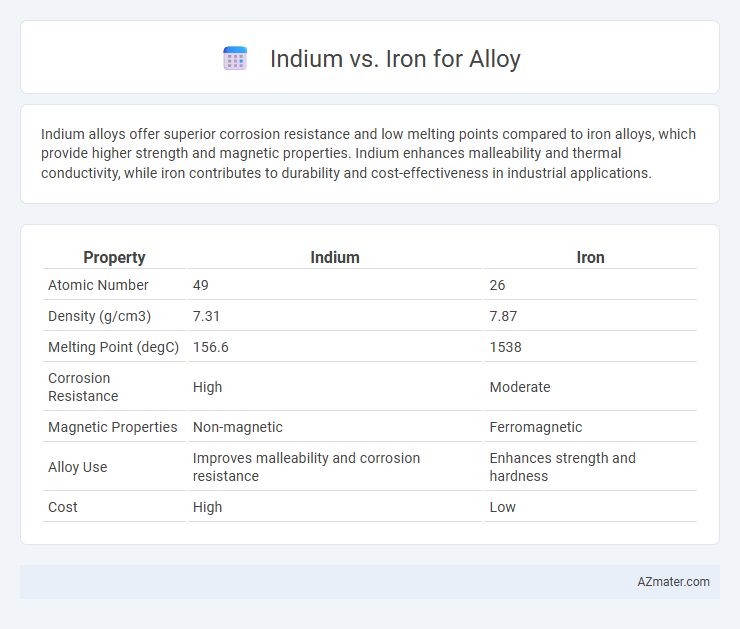Indium alloys offer superior corrosion resistance and low melting points compared to iron alloys, which provide higher strength and magnetic properties. Indium enhances malleability and thermal conductivity, while iron contributes to durability and cost-effectiveness in industrial applications.
Table of Comparison
| Property | Indium | Iron |
|---|---|---|
| Atomic Number | 49 | 26 |
| Density (g/cm3) | 7.31 | 7.87 |
| Melting Point (degC) | 156.6 | 1538 |
| Corrosion Resistance | High | Moderate |
| Magnetic Properties | Non-magnetic | Ferromagnetic |
| Alloy Use | Improves malleability and corrosion resistance | Enhances strength and hardness |
| Cost | High | Low |
Introduction to Indium and Iron Alloys
Indium alloys are prized for their low melting points, excellent corrosion resistance, and high ductility, making them ideal for specialized applications like soldering and thermal interface materials. Iron alloys, particularly steels, offer exceptional strength, durability, and versatility, widely used in construction, automotive, and machinery industries. Comparing indium and iron alloys highlights the distinct advantages of indium for electronics and precision bonding versus iron's dominance in structural and heavy-duty applications.
Chemical Properties of Indium vs Iron
Indium exhibits a low melting point of 156.6degC and excellent malleability, making it suitable for low-temperature alloys and applications requiring high corrosion resistance, whereas iron has a higher melting point of 1538degC and is characterized by its magnetic properties and significant tensile strength. Chemically, indium resists oxidation under normal conditions, forming a protective oxide layer that prevents further corrosion, while iron is prone to rusting due to its rapid oxidation in the presence of moisture and oxygen. Indium's softness and non-magnetic nature contrast with iron's hardness and ferromagnetism, influencing their roles within various alloy formulations.
Physical Characteristics: Indium and Iron Alloys
Indium alloys exhibit low melting points, excellent malleability, and high corrosion resistance, making them ideal for applications requiring flexibility and thermal conductivity. Iron alloys, such as steel, demonstrate superior tensile strength, hardness, and magnetic properties, suitable for structural and industrial uses. The physical characteristics of indium alloys emphasize softness and conductivity, whereas iron alloys prioritize durability and mechanical robustness.
Alloying Behavior: Indium Compared to Iron
Indium exhibits low solubility in iron and forms limited solid solutions, resulting in distinct microstructures compared to typical iron-based alloys. The alloying behavior of indium is characterized by its ability to improve corrosion resistance and reduce brittleness when added in small quantities to iron matrices. Unlike iron, indium's low melting point and limited diffusion enable unique phase formations and enhanced thermal stability in specialized alloy applications.
Mechanical Strength and Durability
Indium alloys typically exhibit lower mechanical strength compared to iron-based alloys, limiting their use in load-bearing applications but offering excellent malleability and corrosion resistance. Iron alloys, particularly steel, provide superior tensile strength and durability, making them ideal for structural and heavy-duty components. The choice between indium and iron alloys depends on the need for flexibility and corrosion resistance versus high mechanical strength and long-term durability.
Corrosion Resistance: Indium vs Iron Alloys
Indium alloys exhibit superior corrosion resistance compared to iron alloys, especially in acidic and saline environments, due to indium's ability to form a stable oxide layer that protects the metal surface. Iron alloys, while strong and widely used, are more prone to oxidation and rust when exposed to moisture and corrosive agents, requiring additional treatments for enhanced durability. The unique chemical stability of indium-based alloys makes them preferred in applications demanding long-lasting corrosion resistance and minimal maintenance.
Industrial Applications of Indium-Iron Alloys
Indium-iron alloys exhibit unique properties such as enhanced corrosion resistance, improved thermal stability, and excellent electrical conductivity, making them valuable in specialized industrial applications like electronics, aerospace, and cryogenic engineering. The combination of indium's malleability and iron's strength results in alloys suitable for manufacturing precision components, including sensors, magnetic materials, and superconducting devices. These alloys outclass pure iron in applications requiring a balance of ductility and durability under extreme environmental conditions.
Cost Comparison: Indium vs Iron as Alloying Agents
Indium, significantly rarer than iron, commands a much higher price per kilogram, with market values often exceeding $500 compared to iron's few cents per kilogram. The cost disparity is primarily due to indium's limited availability and complex extraction processes, while iron is abundant and widely produced. Consequently, alloys incorporating indium incur substantially greater material costs than those using iron, making iron-based alloys more economical for large-scale industrial applications.
Environmental Impact and Sustainability
Indium alloys exhibit lower environmental impact compared to iron alloys due to indium's recyclability and reduced mining footprint, as indium is mainly recovered as a byproduct from zinc and copper ores, minimizing additional ecological disturbance. Iron's extraction and processing generate higher greenhouse gas emissions and greater energy consumption, contributing to deforestation and habitat loss through extensive mining operations. Sustainable alloy development increasingly favors indium for electronics and solar applications despite its scarcity, while iron remains widely used in construction due to abundance but requires enhanced recycling methods to mitigate environmental degradation.
Choosing the Right Alloy: Indium or Iron?
Choosing the right alloy involves evaluating indium's unique softness, excellent corrosion resistance, and superior solderability against iron's strength, magnetic properties, and cost-effectiveness. Indium alloys excel in applications requiring flexibility and thermal conductivity, such as electronics and cryogenics, while iron alloys dominate structural uses due to their tensile strength and durability. Understanding the specific performance requirements and environmental conditions ensures optimal material selection between indium and iron alloys.

Infographic: Indium vs Iron for Alloy
 azmater.com
azmater.com